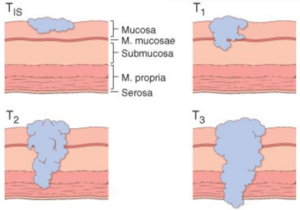A16. Classifications of malignant tumors. TNM-grading.
It’s important for physicians to be able to communicate information about tumors in a standard, unambiguous way. By creating criteria, we can more easily determine the clinical behaviour of the tumor. To do this, we created two description protocols for cancers: grading and staging.
Grading of a cancer describes its degree of differentiation, i.e. how similar the cancer cells are to the corresponding healthy types of cell. A cancer is said to be well-differentiated if it acts like healthy tissue would, e.g.:
- It is epithelial in origin and produces keratin
- It is glandular in origin and produces gland-like structures
- Its cells show low degree of pleomorphism
- Not a high number of mitotic figures can be seen
Well-differentiated tumors are less aggressive generally, so the more well-differentiated a tumor is, the lower its “grade”. A low-grade tumor is well-differentiated, a high-grade tumor is poorly differentiated or even anaplastic. We can divide tumors into 2, 3 or 4 “grades”:
| Four-tier grading | Three-tier grading | Two-tier grading | ||||||
|---|---|---|---|---|---|---|---|---|
| Grade 1 | Low grade | Well-differentiated | Grade 1 | Low grade | Well-differentiated | Grade 1 | Low grade | Well-differentiated |
| Grade 2 | Intermediate grade | Moderately differentiated | Grade 2 | Intermediate grade | Grade 2 | High grade | Poorly differentiated | |
| Grade 3 | High grade | Poorly differentiated | Grade 3 | High grade | Poorly differentiated | |||
| Grade 4 | Anaplastic | Anaplastic | ||||||
Which system we use depends on the type of tumor.
TNM system

Staging is another system that is has more clinical value than grading. The most common system is the TNM system, which describes the size or extent of the tumor (T), the involvement of lymph nodes (N) and whether there’s metastasis or not (M). The system works like this:
| T | N | M | |||
|---|---|---|---|---|---|
| Tx | Tumor can’t be evaluated | Nx | Lymph nodes can’t be evaluated | M0 | No distant metastasis |
| T0 | No evidence of tumor | N0 | No tumor cells in sentinel lymph node | M1 | Metastasis to distant organs |
| Tis | Carcinoma in situ | N1 | Tumor cells present in sentinel lymph node | ||
| T1 | Size and extension of tumor on a scale from 1-4 | N2 | Between N1 and N3 | ||
| T2 | N3 | Tumor cells has spread to distant or numerous regional lymph nodes | |||
| T3 | |||||
| T4 | |||||
So a colorectal cancer which had spread to the submucosa, has spread to numerous lymph nodes and has no metastases would be T1 N3 M0.
